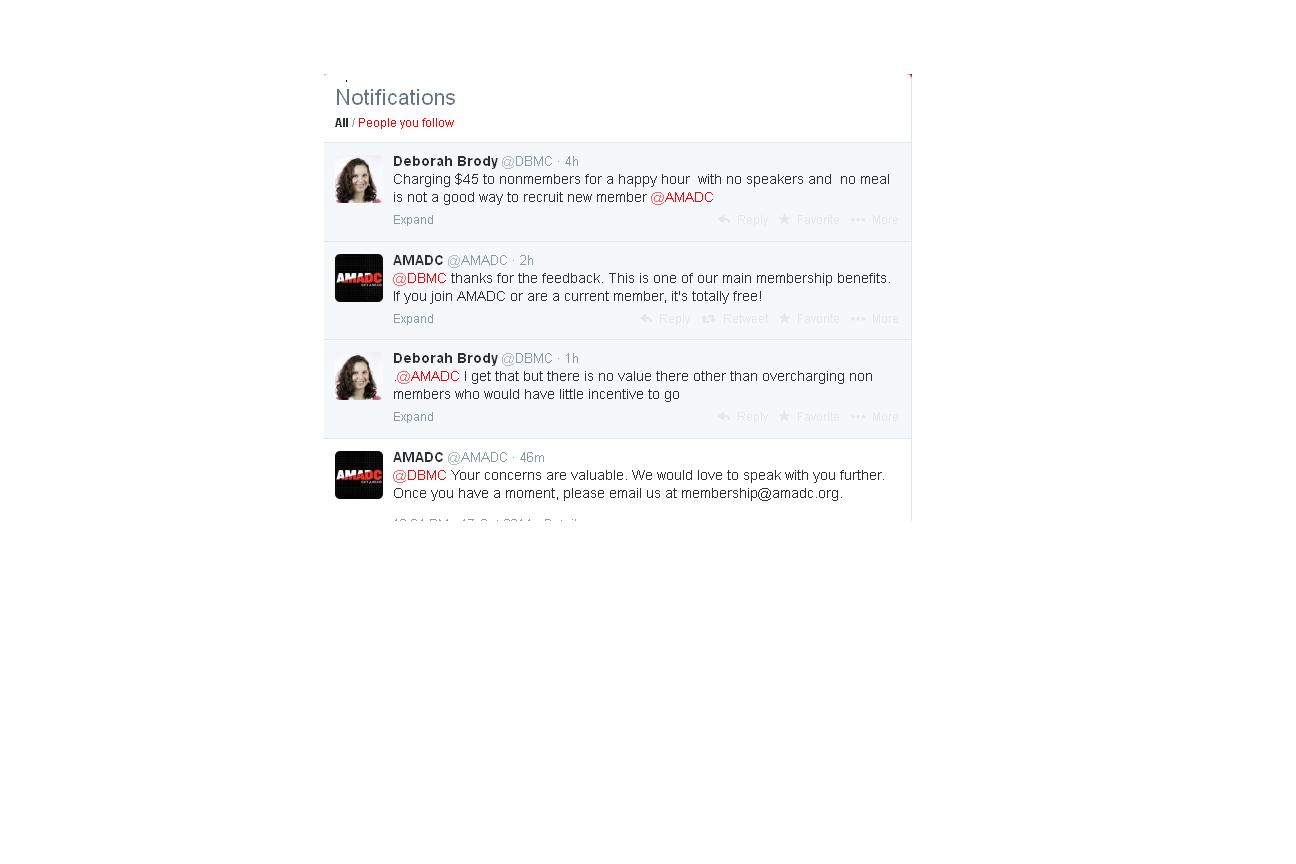What’s the goal behind the AMADC’s $45 happy hour?
Note: AMADC is the Washington, DC chapter of the American Marketing Association (AMA) , which is a membership organization with chapters around the country. I am not a member of the AMA or AMADC, although I have attended its events in the past.
Last Friday, the AMADC tweeted about its upcoming happy hour (or AMA Networking Events as they call them) at a DC restaurant. I clicked on the link and found out that to attend the happy hour, non-members must pay $45 while members can attend free. According to what I saw, the happy hour/networking event is a chance to mingle with other people. This is a description from the AMADC website:
AMADC Networking Events are the place to get dialed into the DC marketing community. Make alliances for your business, find your next great employee, get active in the AMA, get career advice or maybe get your next job. Be sure to bring a ton of business cards, you are going to need them
There is no program, no speaker and at least from what I can see, no food or drink included in the price of admission. Just a chance to meet people (maybe).
Here’s my conversation with AMADC on Twitter:
According to the @AMADC response above, the free happy hour for members is a “main benefit of membership.” This however, is not even mentioned in the AMADC’s website membership benefits page.
(Annual membership in AMADC is $285, of which $220 is for national dues and $65 for chapter dues.)
So, what is the marketing/strategic goal for the AMADC happy hours? Is the goal to reach non-members and show them value?
Are these happy hours simply membership perks? If so, fine. If I am understanding this correctly, members get to feel as though they are “saving” $45 for each “networking event.
Here’s a question though: members don’t have to pay extra to attend. And while this may be a benefit of membership, just how valuable is it? Remember cost is not equivalent to value.
But, if these happy hours/networking events are also a chance to reach out to non-members and perhaps even to recruit new members, then charging $45 is not accomplishing that goal. I can tell you that from experience, specifically with the AMADC.
When I first moved to DC nearly ten years ago, I attended one of the AMADC happy hours at a bar downtown. The cost then was $25 (why the nearly 100% increase is another question). I got to the bar, where I knew nobody. There was a section reserved for the AMA ( right off the main bar, and not even clearly marked off). They offered no snacks, or drinks (or even discount drinks other than the regular happy hour stuff ). There were no name tags. Nobody offered to act as an AMA ambassador and welcome people. I tried talking to a couple of people but having a conversation over the bar’s loud background noise was near impossible. In short, it was a waste of time and money. I could’ve just gone to the bar on my own, ordered a beer, sat right next to the AMA DC section, and gotten as much out of it while saving $25.
Is the AMADC’s goal to be in line with other organizations in town?
Meanwhile, the other membership organizations in town also host monthly happy hours, however, this charge of $45 for a happy hour is the highest I have seen. For example, IABCDC does not charge for its happy hours. Everyone pays for what they consume. Various communications meetups such as DC PR Flacks don’t charge either. The PRSA-NCC charges everyone for its PRO Net happy hours ($10 for members and $15 for non-members) but the fee includes a free drink and appetizers.
Is the goal to encourage networking among members?
Other organizations charge between $35 and $65 for non-members to attend chapter meetings, professional development events or luncheons/dinners. In fact, AMADC charges $50 to non-members and $30 for members for its professional development events. Bear in mind that at a professional development event or at a meal, people are getting a tangible benefit.
Why would networking be considered a more important benefit than professional development? Why not make professional development the perk of membership?
Is the AMADC’s goal to make money off networking events?
Obviously, when there is a cost involved for the organization (the meal, the room rental, etc.), there is a reason to charge both members and non-members. Many organizations use sponsorships to defray the overhead costs, and so that they can offer discounts to their members. For the upcoming AMADC happy hour, a local organization is sponsoring the event. Since people have to pay for their drinks and food, there is no cost to the AMADC other than a room rental or guarantee fee, which I assume is being covered by the sponsorship. The non-member fee would seem to be a money-maker.
Is the goal to show non-members what they would save?
Perhaps the AMADC is imagining a scenario where a non-member signs up for this event, has a wonderful time and makes a lot of new contacts, and figures that if he or she signs up for membership, he/she could go to this events “for free” thus “saving” $45.
So what are the AMADC’s goals?
I don’t know and I can’t tell what the AMADC’s goals are. It’s not clear to me what it is aiming to accomplish by charging so much for a happy hour. In my opinion, there is little value to a happy hour and very little reason to spend $45 to attend one. Yes, I understand there is a networking opportunity. But as mentioned above, there are many other free and lower cost opportunities in town. Plus, going to a happy hour at a loud bar is not necessarily the best way to network.
What do you think? Would you pay this fee? Why or why not?


